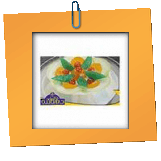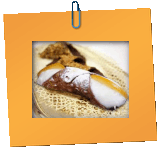Culinary Information
Alivvi a puddascedda: The stone
is removed from the previous year’s brined olives and
cooked with chopped cardoons and flavoured with mint,
garlic and vinegar.
|
Cudduruni: The leavened dough is flattened and filled with, depending on the season, broccoli, wild chard, onions, potatoes, etc. and flavoured with fresh pecorino cheese, tomato puree, anchovies and oil. The dough is then folded, closed and baked in an oven.
|
|
Baccalaru a ghiotta: The dried cod is soaked in water and then boiled with potatoes, olives, onions, capers and tomato sauce.
|
Faccia di vecchia: The pizza is flavoured only with tomato puree, a lot of garlic, some cheese, oil and oregano.
|
|
Brocculi affucati: The broccoli are simmered with onions, parsley, cheese, wine and tomato sauce.
|
Larunchi: The frogs, after being cleaned, are cooked for no more than half an hour with browned onions, diced tomatoes and water.
|
|
Cacocciuli arrustuti: The artichokes are flavoured with garlic, parsley, salt and oil and then slowly cooked on embers.
|
Maccu di favi secchi: After having soaked overnight, the broad beans are boiled in water that has been flavoured with wild fennel. Once cooked they are sieved
|
|
Capunatina: The aubergines are chopped, salted and then left to lose their liquid and consequently cooked with white olives, capers, celery, onions, tomato puree, sugar, vinegar, olive oil.
|
'nsalata d'aranci: : blood oranges cut into small pieces with the 'addition of onion, oregano, olive oil and red chili pepper.
Passiluna: Sultanas are desiccated muscat grapes and used especially in cake recipes.
|
|
Ciciri caliati: chickpeas are placed in hot boiling salted water and left to leaven. They are then toasted on sea sand.
|
 |
|
|
|
|
Capuliatu: After having peeled and removed the seeds from the tomatoes, they are sieved. Salt is added and the puree is put in dishes from Caltagirone and then left under the sun to desiccate. The tomato puree is then put into glass jars with some basil leaves.
|
Moscardini: Flour, hot water and sugar are kneaded together and then the dough is left to leaven for 24 hours. The dough is then cut into small pieces and baked in an oven – when the sugar comes into contact with the oven’s heat it causes the dough to change into various shapes.
|
|
Chiappareddi:
After being washed and cut in half, the tomatoes are
salted and then put out under the sun to desiccate.
|
Sfingi:
Flour, water and yeast are kneaded until a liquid batter is obtained. After the batter has leavened, very small quantities (a teaspoon full) are fried in boiling oil and then rolled in honey. They are eaten hot.
|
|
Ficu sicchi: The figs are cut in half and desiccated under the sun on a wooden board and covered with a veil. When they have dried, they are tied to a string.
|
Suspiri di monichi: Biscuits made from flour, egg white, sugar and grated lemon rind. Strips that are bigger than a finger are cut from the dough and then baked in a medium heat oven.
|
|
Mustadda: After having been peeled, the prickly pears are cooked with orange rind and carobs. When cooked, they are sieved to separate the pulp from the seeds. Flour and cinnamon are added to the puree and further cooked. The puree is then placed in special moulds and left out in the sun to desiccate.
|
Turruni ca mennula: Honey, sugar and blanched almonds are put into a pot and simmered, mixing all the while with a wooden spoon. When finished cooking, the mixture is placed on a marble surface and spread to a thickness of about 2 cm. When cooled down, it is cut into rectangular pieces.
|







